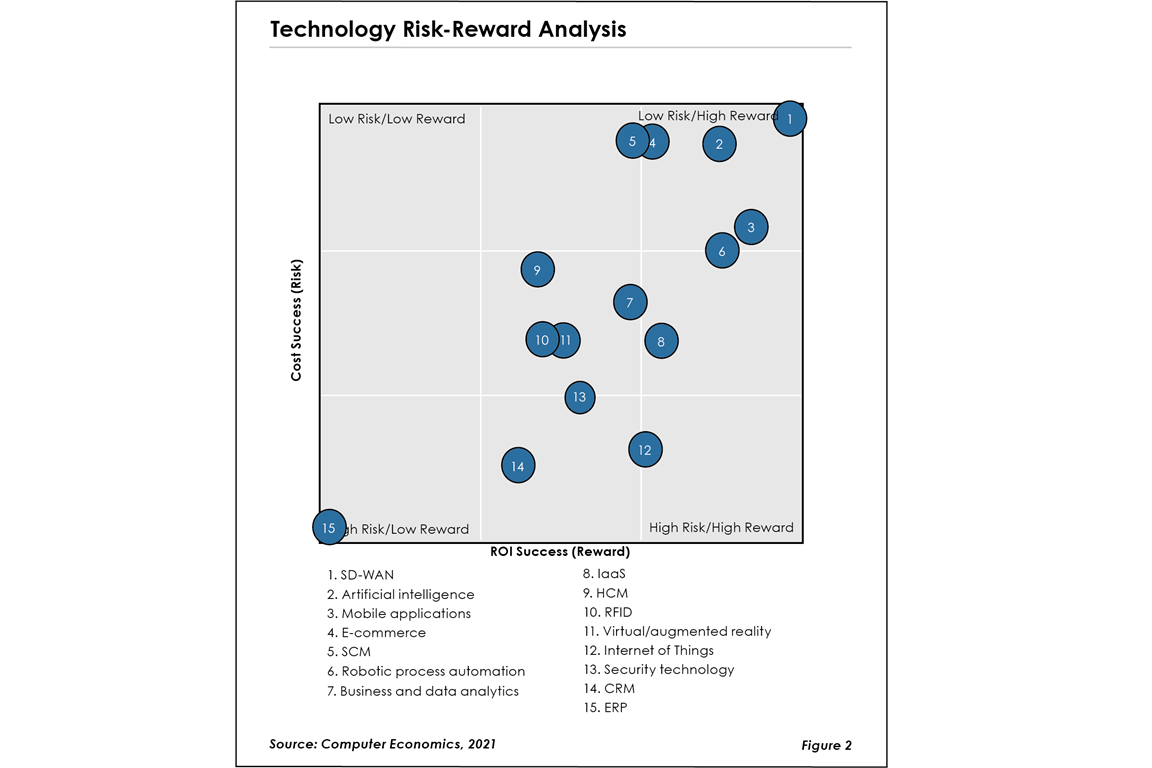With the COVID-19 pandemic, the network is at the front and center of resiliency discussions, now so more than ever. Network services have further gained importance, especially for improving business agility and flexibility—which we have known for a while. While adoption of SD-WAN was slow at first, we expect it to continue to pick up steam as companies adjust to the realities of more complex networks brought on by working from home, adoption of cloud and SaaS, IoT, and other factors. SD-WAN finished first on the risk-reward analysis spectrum this year in our annual study of technology trends.
As shown in Figure 2 of our Technology Trends 2021 study, SD-WAN ranks first in our risk-reward analysis, which compares ROI success with the success of bringing in projects within budget (TCO). Ranking high on the upper right of this chart means that not only are companies seeing ROI from their projects, but they are also having success meeting budget constraints.

SD-WAN is the use of software-defined networking technology to establish and operate a wide-area network by virtualizing network resources. Why is SD-WAN use projected to grow in the coming years, and why is the risk/reward profile so favorable? There are several reasons, and it all starts with the need for flexibility and to reduce capital and operating costs in regard to networks. An SD-WAN creates more-consistent networking performance and allows companies to provision network resources based on how busy applications are so that performance levels are maintained across all apps. Moreover, SD-WAN allows an organization to reconfigure networks much more easily.
SD-WAN is also a money saver. It reduces maintenance and makes it easier to set up networks with lower capital costs and fewer staff members. Other factors behind SD-WAN’s growth include its built-in security advantages and the fact that it helps balance networks to ensure all applications are getting the resources required to run effectively.
“SD-WAN adoption will grow hand-in-hand with digital transformation,” said Tom Dunlap, director of research for Computer Economics, a service of Avasant, based in Los Angeles. “Enterprise networks are getting more complex as they adopt more cloud and IoT. The agility, cost certainty, and ROI makes SD-WAN a no-brainer for many companies. The only thing holding it back is the amount of money tied up in legacy networks.”
One way to tell when a technology is heating up is by the number of acquisitions. That is the case with SD-WAN. Some of the recent examples include Hewlett Packard Enterprise buying Silver Peak Systems, Palo Alto Networks acquiring CloudGenix, and Canadian firm Adaptiv Networks scooping up Elfiq Networks.
The full study is designed to give business leaders insight into the staying power of 15 technologies that are currently top of mind for many companies. It provides a glimpse into how quickly an emerging technology is being adopted, how deeply more-established technologies are penetrating the market, and how positive the customer experience is with each technology. The study also delves into the specific types of solutions under consideration.
By understanding the adoption trends, investment activity, and customer experience, business leaders are in a better position to assess the potential risks and rewards of investing in each of these technology initiatives. They also can gain insight into just how aggressively competitors and peers are investing in these initiatives.
The full study also takes a quick look at an additional 18 early adopter and future technologies. These include blockchain, digital currencies, digital assistants, drones, autonomous vehicles, quantum computing, 5G, no-code/low-code, electronic tattoos, electronic textiles, exoskeletons, facial recognition, microchip implants, 3-D printing, brain-computer interfaces, self-healing systems, volumetric displays/holograms, and digital twins. The study evaluates whether IT decision makers are familiar with these, whether they see a potential use for them, and whether they have already implemented them or have them installed.
Sample pages from the full study are available for free download.
This Research Byte is a brief overview of our study, Technology Trends 2021. The full report is available at no charge for Computer Economics clients, or it may be purchased by non-clients directly from our website (click for pricing).





